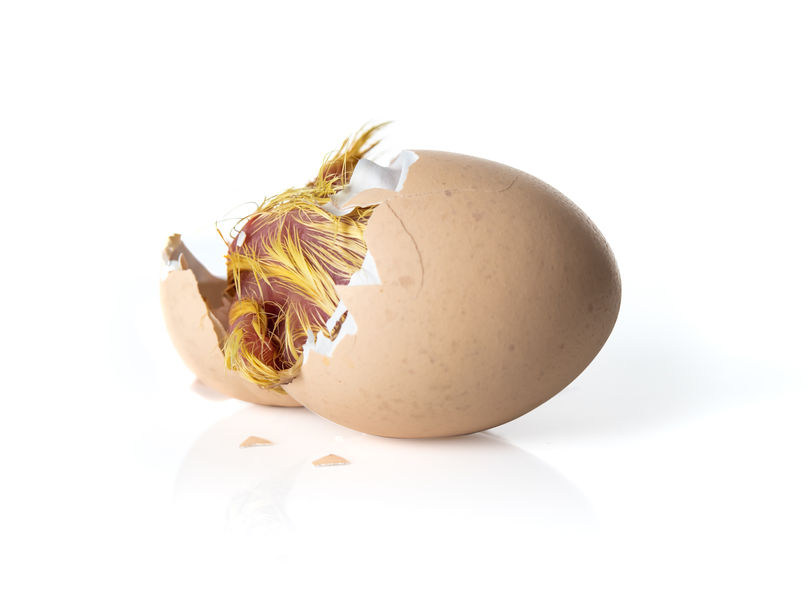Suppose you don’t have a rooster, no worries. No incubator? No problem. Believe it or not, you don’t need either. That’s right! In this article, we’ll show you how to hatch chicken eggs without an incubator. A broody hen will take care of it for you.
However, there is a process involved to get things set up, which includes a separate nesting box, fertilized eggs, brooder, food and water. We’ll get to the nitty gritty below!
You are probably scratching your head, wondering just how the heck are we going to hatch those eggs.
Well, we are going to rely on good ole mother nature by hatching your eggs with the help of one of your hens. The old-timers have used this method to hatch fertile eggs for a gazillion years. You have the perfect incubator right in your coop.

Pros And Cons Of Brooding vs. Incubator
As with any endeavor you take on, there will always be pros and cons.
Brooding |
Using An Incubator |
Pros
Cons
| Pros
Cons
|
Preparation
Hold on before running out and putting eggs up underneath your chicken in the nesting box. Hatching fertile eggs isn’t as simple as that. We have to strategically encourage nature to take the lead in hatching after we have done a little planning.
So, just to refresh you, to have fertile eggs that chicks are hatched from, you must have a rooster and a hen who mate. That hen’s eggs she lays will be fertile. Hens are going to lay eggs even if you don’t have a rooster (these eggs are sterile.)
Now we are going to assume you have no rooster and no fertile eggs.
Here’s the plan:
- Set up a brooder box away from the flock. This will be where the broody hen you select will sit on the eggs and mother the chicks until they are old enough to advance to a larger area. The area should be warm and quiet.
Here are a few ideas on what you can use for a nesting area.
- Large dog crate (with walls on three sides)
- Foldable/portable play crib
- Pop-up tent
- Extra-large cardboard box
- DIY Build It Yourself
Include:
- Look for a broody hen in your flock. Broody hens are the ones who lay eggs and don’t want to leave them. Her mothering instinct is in high gear but little does she know those eggs will never hatch. You are about to rock her world by giving her fertile eggs to sit on instead.
You’ll know you have one if she does several things.
- She never leaves the nesting box.
- She lays eggs in places outside of the nesting box.
- If you attempt to lift her up to remove the eggs, she becomes cranky.
- Completely picking her up and taking her out of the nesting box causes her to act a bit strange (her feathers fluff up, she is verbal, she takes on a low profile.) If she’s able to get back into the nesting box, she does so as fast as possible.
- Time to get your fertilized eggs. You can purchase them from a local breeder or someone you know who raises chickens. Remember that your broody hen can only sit on about three to five fertile eggs. Bantams should have less.
Now it’s time to put your plan into action! Are you ready?
Move The Broody Hen To The Brooding Box
First, place the fertilized eggs in the nesting box, which is inside the brooding box. Be sure the feeder and waterer are full. Pick up and carry the broody hen over to the brooding box and place her on top of the fertile eggs.
Suggestions for brooding boxes can be found in this article.
Rather than hover over her and continually checking on her, it’s best to leave her alone. Refresh her water, fill her food, and do minimal cleaning as needed, but that’s it. Let nature take its course.
Now there’s no guarantee the hen will sit on the eggs. Allow her a few days to acclimate. Fertile eggs will be fine, providing the temperature isn’t at or below freezing. If after a few days she refuses, you may need to find another broody hen or resort to using an incubator to avoid losing the eggs.
Mark your calendar for hatching 21 days from today once those eggs are “in the oven” (under a broody chicken.)
Hatching Day
Around day 21, you should hear tiny chirps from the brooding box. This is the fun part!
The hen and chicks will leave the nest to find water and food, where she will teach them how to eat and drink.
While she is out of the nesting box, remove any remaining eggs and eggshell. Change the bedding and clean as best as possible.
Newborn chicks are unable to regulate their body temperature. They rely on the hen to keep them warm. Supplying them with heat can also be done by adding a brooding lamp that supplies radiant heat. We never recommend using bulb-style lamps because of the high risk of fire danger.
After a week or two, you can relocate them to a separate area that is larger. Keeping them confined to a small brooding box leads to problems with ammonia buildup.
The chicks cannot be introduced to the flock until they are at least a month or older.

The Last “Cluck”
Hatching eggs in a more natural way such as this makes for happier chicks. Incubators are more of a convenience for us. However, they unfortunately bypass crucial steps that are important in a chick’s life.
Perhaps if we were to imagine ourselves coming into the world in a container void of a mother, it might help us to pause and take stock of our choice of brooding or using an incubator.
Happy “chickening!”


